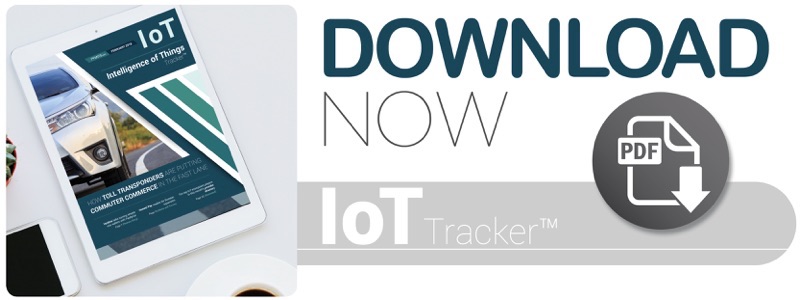TRENDING: Is E-ZPass An Easy In-Vehicle Payments Play?
When drive-throughs broke onto the scene in the late 1940s, “innovative convenience” meant replacing a fleet of carhops with an intercom ordering system and a pick-up-and-pay window. Fast forward to today, and Internet of Things (IoT) tech is enabling in-vehicle payments to put car-based commerce in the fast lane.
IoT is also being applied outside the quick service restaurant (QSR) sector, serving car dealerships, cattle ranches, airports and manufacturers, among other use cases. It’s helping companies track assets over a large space, implement preventative maintenance and pinpoint efficiencies.
The February Intelligence of Things Tracker™ details the latest headlines in the space, including how IoT is giving industries a data-powered boost and creating new retail models.
Around the IoT landscape
Samsung is one force pushing forward with a new, data-rich vision of retail. At the latest National Retail Federation (NRF) BIG Show 2018, the electronics giant demoed a model for implementing IoT across physical pop-up stores for purposes such as capturing real-time data on in-store customers’ traffic and demographics.
While Samsung is exploring new ways to implement IoT, other players are focusing on getting more devices to join the IoT world. Paving the road for the tech to drive forward means IoT solution providers need to be ready to get devices quickly and securely connected. Several major companies believe the answer is in low-power, wide-area networks (LPWAN).
Cisco, for one, is seeing value in LPWAN and seeking to beat the roadblocks to wider adoption. The information and networking technology giant turned to a partnership with software solutions provider Acklio to tackle the lack of interoperability between internet protocols (IPs) and LPWAN.
Meanwhile, Verizon is partnering with Swedish telecom and networking company Ericsson. The pair is aspiring to bring forth more connectivity options with a new Narrowband IoT Guard band network designed for lower data rates.
Turning wheels into wallets
While intended as a speedy way to get a quick bite or cup of coffee on the morning commute, drive-throughs often fall short of their name — think long lines of drivers idling along as they pay with their credit cards or figure out the right change. Automakers are wise to the problem, though, and some companies are working to blend in-vehicle payments into their new car designs.
But it seems drivers won’t have to wait — or buy a whole new car — to take advantage of the offering, according to Kevin Condon, founder and CEO of Verdeva, who spoke to PYMNTS for this month’s feature story. Condon’s company partnered with the E-ZPass toll transponder network to launch the PayByCar program, an offering to help drivers access in-vehicle payments using the same tech that’s often already installed for electronic tolls. It also functions much like the new Amazon Go store.
“[At Amazon Go stores], no payment transactions are occurring at a desk or checkout counter when you leave,” Condon said. “What we’re talking about is an in-vehicle version of that.”
About The Tracker
The Intelligence of Things Tracker™ showcases companies that are leading the way in all aspects of the Intelligence of Things. Every month, the Tracker looks at what these companies are doing in several ecosystem categories, including Personal, Home, Retail, Transportation, Wearable, Mobile, Infrastructure, Data and more.


